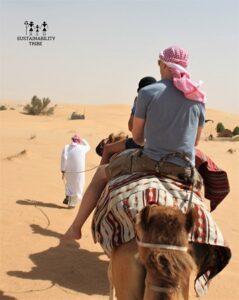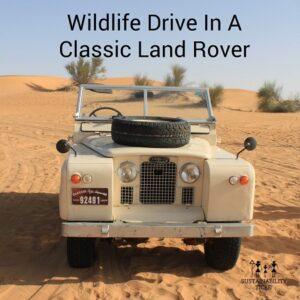DESERT SAFARI WITH PLATINUM HERITAGE WITH BEDUINE BREAKFAST



After breakfast, we went Camel Riding. Riding camels is always fun, this time I particularly loved my ride as he was making some noises, I presumed he was trying to connect with me ;-). But the real fun started when we settled in our 1950’s classic Land Rover in search of wildlife in DDCR!

WILD LIFE DRIVE IN DUBAI DESERT CONSERVATION RESERVE

As we started our drive the wind started blowing the sand and we all had to cover our mouths and nose. I have never been to the desert while sand is blowing in the air, but this made our experience even more authentic! It was mesmerizing to see the sand blowing from the top edge of the dunes.


First, we searched for mountain gazelles and were lucky to find two herds near the water area. There are water areas where water is refilled for wildlife. It was thrilling to see Gazelles jumping, running in the wild. I personally love these creatures, I find them so graceful! So I couldn’t help taking many photos of these desert beauties. Throughout the drive, we took many stops and our guide Oscar introduced us to many flora and fauna in the desert and fun facts about it.
Oscar showed us Sodoms Apple, called Ushar in Arabic. This is an evergreen shrub, it’s beautiful 5 petal flowers are white and dark purple. Milky sap is excreted when any part of the plant is broken. Gazelles eat them to regularize their digestion when they pass hard droppings!

Ushar (Top right), Fire Bush (Top Left), Sand Grass (Bottom 2)
The Firebush, Markh in Arabic Leptadenia pyrotechnica. It has small yellow flowers, these are used in Bedouin food. Its fibers are tough and do not rot in water, so are suitable to be spun into rope. It has been used in carpets since ancient times. Gazelles eat them to regularize their digestion when they pass hard droppings! The animals dig their resting place under the fire bush.

Ramram (Top right), Rimth, Ghaf Tree
Next, we stopped to see sand grass or dune grass called as Thenda in Arabic, Cyperus Conglomeratus. This grass the grown at the base of sand dunes. It may look dead or dried, but the roots go deep and the sand near the roots is wet. It comes under the sedge family. Sedges were once used to make sails, ropes, baskets, mats, and also fuel.
As we came near an area covered with numerous shrubs, we got down to check these interesting bushes. Rimth, Haloxylon Salicornicum is an aloe-like fleshy green shrub without leaves. It has many medicinal uses like curing ulcers, but the interesting fact is in the olden day’s ladies used these plants to make eyeliners.
Ramram, Heliotropium Kotschvi has rough branches covered with stiff white hair. Oscar told us traditionally this plant is boiled with meat to get rid of the strong odor.

Scorpion Burrow, Mushroom, Beetle shell
As we drove deeper into the desert we came across a patch of Ghaf trees and shrubs. Oscar told us, whenever you see Ghaf trees in the desert, there must be groundwater. We decided to explore that area to look for Arabian Oryx if by chance they came to drink water from a small man-made pond created for wildlife. We couldn’t find Oryx here but saw many interesting things like scorpion burrow under the fire bush. Unfortunately, no scorpions were ready to come out. But we could see red desert ants, found a beetle shell, poisonous wild mushroom.

Finally, we saw a herd of Arabian Oryx on top of dunes at the other end. We drove up and down through the dunes while the wind was blowing and sand smashing on our faces. We could go a little closer and I could capture these beautiful animals in my zoom lenses. Arabian Oryx also called Al Maha in Arabic is the only antelope who can give birth to twins. Arabian oryx, a native of the Arabian peninsula were declared extinct in wild by the early 1970s but saved in zoos and private reserves. By 1986, it was listed as endangered on ICUN’s red list. In 2011, it was the first animal to revert to vulnerable status after previously being listed as extinct in wild. Thanks to all those organizations in the middle east and of course Dubai Desert Conservation Reserve! Such a great story of conservation success! Did you know Arabian Oryx is UAE’s national animal! You could imagine how memorable those moments are for me to see Arabian Oryx in wild!

We learned many things about wildlife, their habits, and habitat; biodiversity in the desert. Some of the zones in DDCR are protected only for research, we came across one of them during our drive. I felt like transported to a remote location in this vast empty quarter where there is no trace of urban civilization! I am so glad, I finally decided to visit DDCR, after thinking about it for many years!

I am definitely going back there again, maybe to explore wildlife at night next time and to see all those animals, reptiles, camel spiders and snakes which I missed this time!
When you are going in the desert, don’t forget to get a copy of our UAE Outdoors Scavenger Hunt E-book. This unique ebook will add some fun games to your outdoor trip and will help you get to know UAE’s biodiversity and nature even better.


